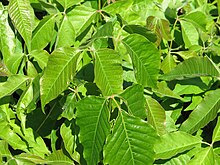
Back سماق سام Arabic سماق سام ARZ Toxicodendron Catalan Toxicodendron CEB Jedovatec Czech Giftsumak Danish Toxicodendron German Toxicodendron Spanish Mürgipuu ET Toxicodendron EU
| Toxicodendron | |
|---|---|

| |

| |
| Two pictures of Toxicodendron radicans | |
| Scientific classification | |
| Kingdom: | Plantae |
| Clade: | Tracheophytes |
| Clade: | Angiosperms |
| Clade: | Eudicots |
| Clade: | Rosids |
| Order: | Sapindales |
| Family: | Anacardiaceae |
| Subfamily: | Anacardioideae |
| Genus: | Toxicodendron Mill.[1] |
| Species[2] | |
|
29; see text | |
| Synonyms[2] | |
| |
Toxicodendron is a genus of flowering plants in the sumac family, Anacardiaceae. It contains trees, shrubs and woody vines, including poison ivy, poison oak, and the lacquer tree. All members of the genus produce the skin-irritating oil urushiol, which can cause a severe allergic reaction. The generic name is derived from the Greek words τοξικός (toxikos), meaning "poison," and δένδρον (dendron), meaning "tree".[3] The best-known members of the genus in North America are eastern poison ivy (T. radicans) and western poison oak (T. diversilobum), both ubiquitous throughout much of their respective region.
The resins of certain species native to Japan, China and other Asian countries, such as lacquer tree (T. vernicifluum) and wax tree (T. succedaneum), are used to make lacquer, and, as a byproduct of lacquer manufacture, their berries are used to make japan wax.
- ^ "Toxicodendron Mill". Germplasm Resources Information Network. United States Department of Agriculture. 2009-11-23. Retrieved 2010-02-12.
- ^ a b "Toxicodendron Mill". Plants of the World Online. Royal Botanic Gardens, Kew. Retrieved 4 November 2024.
- ^ Gledhill, D. (2008). The Names of Plants (4 ed.). Cambridge University Press. p. 382. ISBN 978-0-521-86645-3.